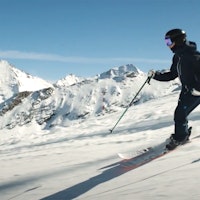When it comes to exciting gear purchases, boots can sometimes take a backseat to a new pair of skis, but this should not be the case. These oversized, hard-plastic shoes are arguably the most essential piece of the puzzle—the all important bond between you and your equipment. And fit can make or break your season.
Be sure to read our 2012/2013 boot reviews here.
Bootfitters
When hunting for a new pair of boots, your first step is to find a reputable shop with good bootfitters. Ask around. When somebody gets their boots dialed in just right, they’ll tell you about it—as well as who made it happen for them. While buying skis is mostly discretionary, boot selection is somewhat predetermined by the anatomy of your feet, and you need to involve somebody who knows how to properly examine them. Stephen McDonald, a certified pedorthist and bootfitter at Jackson Hole Sports, points out that “boot companies have gotten very good with anatomical fits over the years,” and part of his job is to know which models fit which types of feet.
In addition to your foot type, you’ll want to discuss your style of skiing and what functionality you need in a boot. Are you lapping the park or spending your days in the backcountry? After a thorough foot examination and quick discussion of your skiing preferences, you can swiftly narrow down which models will work for you while ruling out ones that might cause problems. Most of us have brand or style preferences, but you should go into this process with an open mind and soak up the knowledge these professionals have to offer. “Bring your own socks,” says McDonald, and “be prepared to spend a few hours.” You’ll benefit greatly from this time.
Shell Types
There are two distinct shell types on the market, the three-piece (also known as the three-buckle or cabrio) and the two-piece (also known as the four-buckle or overlap). The primary difference is in the flex. A ribbed tongue is the pivotal part on a three-piece boot, which Full Tilt’s Jason Levinthal likens to a flexible straw. There’s no restriction on the movement, “So what you get is a smooth, progressive flex that enables you to move more naturally on the snow,” he says. A major plus with this design is that the tongue is easily swapped out to adjust stiffness. As for fit, a low, flat and narrow foot works best in this boot.
A four-buckle boot can be thought of as having two cylinders, one around your forefoot and one around your shin. The pinch point, between the second and third buckle, is where the boot will stop flexing and start driving the ski, which isn’t necessarily a bad thing but can jar some skiers. The flex of this design relies on the thickness of the plastic and the secure attachment of the rear cuff to prevent over-flexing. Keep this shell in mind if you have a higher instep as there is no buckle directly over that area. “They dominate the market for a reason,” says McDonald, “They are powerful and they hold your foot securely.”
Aside from the fit—three-piece tends to have a lower instep—it really comes down to personal preference between the two. In what way do you want your boot to flex? Some people have grown to prefer one type over another, but you should put your foot in both to get a feel for them.
Hike Modes
As backcountry skiing has become more prevalent, so too have hiking modes. In its early days, this feature in alpine boots caused performance problems, as the cuff would often move around while in ski mode. Matt Rihm of Lange says he understands people’s hesitation but points out, “These problems arose from companies trying to beef up touring boots, as opposed to starting with an alpine boot and adding the functionality of a hiking mode.” The latter is the approach that Lange took with its new XT 130 boot, and you can look for better performing boots around the industry as design continues to move in this direction.
Customization
Once you have chosen your new boots, you’ll want to get them tailored to your feet. Most of the boots on the market come with some form of customization, such as heat-moldable liners and shells. Work with your bootfitter to take advantage of these, and point out any pressure points, no matter how slight, as these can build over time and cause painful bone spurs. Most stock footbeds leave something to be desired, so replacing them with a more supportive alternative is usually not a bad idea. Options range from relatively cheap drop-in supports to pricey custom orthotics. You’ll get what you pay for, but your arches will appreciate any amount of additional support.
Now that you have your boot dialed in, it’s time to hit the snow. But don’t be afraid to revisit your bootfitter—ideally the same one—as the season wears on. Build a relationship with your fitter and deal with problems as they arise, not letting small issues turn into big problems. Don’t forget to pull your wet liners out to dry when you’re done with your day, and always remember to thank your bootfitter, who has just made your season a whole lot better.


![[GIVEAWAY] Win a Head-to-Toe Ski Setup from IFSA](https://www.datocms-assets.com/163516/1765920344-ifsa.jpg?w=200&h=200&fit=crop)
![[GIVEAWAY] Win a Legendary Ski Trip with Icelantic's Road to the Rocks](https://www.datocms-assets.com/163516/1765233064-r2r26_freeskier_leaderboard1.jpg?w=200&h=200&fit=crop)


![[GIVEAWAY] Win a Legendary Ski Trip with Icelantic's Road to the Rocks](https://www.datocms-assets.com/163516/1765233064-r2r26_freeskier_leaderboard1.jpg?auto=format&w=400&h=300&fit=crop&crop=faces,entropy)




![[GIVEAWAY] Win a Head-to-Toe Ski Setup from IFSA](https://www.datocms-assets.com/163516/1765920344-ifsa.jpg?auto=format&w=400&h=300&fit=crop&crop=faces,entropy)


